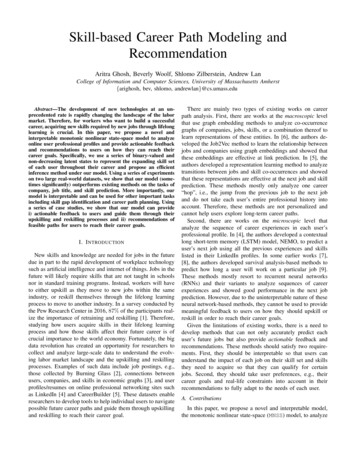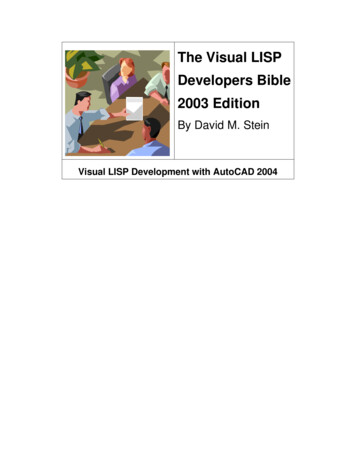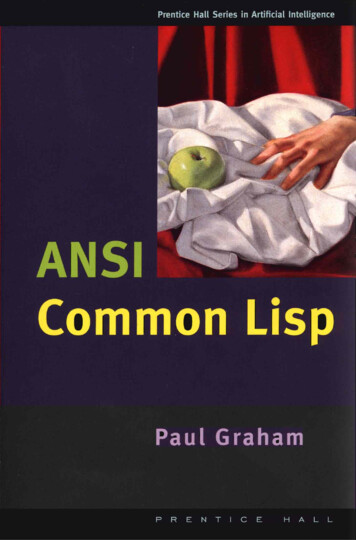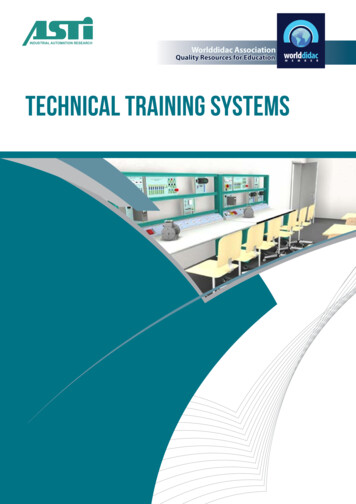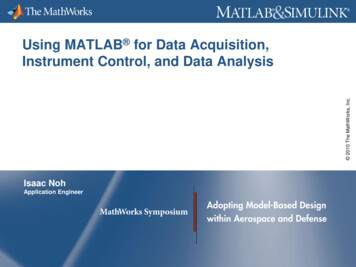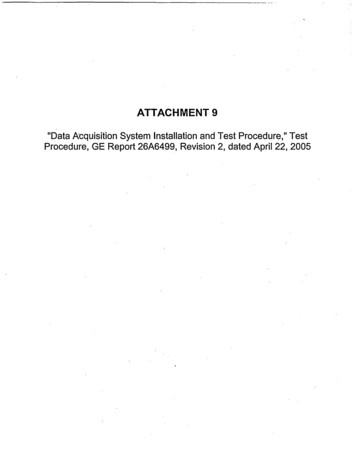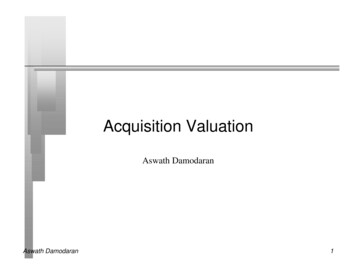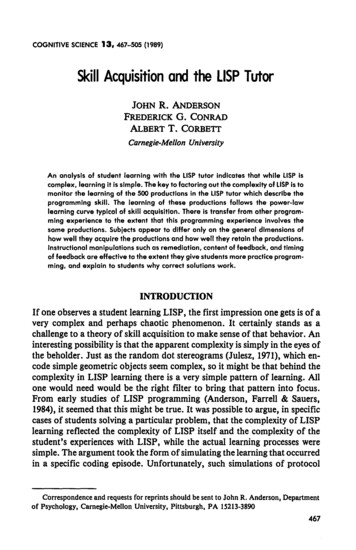
Transcription
d the LISPTutorJOHN R. ellon UniversityAn onolysisof studentlearningwith the LISP tutor indicatesthot while LISP iscomplex,learningit is simple.The key to factoringout the complexityof LiSP is tomonitorthe leorningof the 500 productionsin the LISP tutor which describetheprogrommingskill.The learningof theseproductionsfollowsthe power-lowlearningcurvetypicalof skill acquisition.There is transferfrom other progromming experienceto the extentthat this programmingexperienceinvolvesthesome productions.Subjectsoppeorto differonly on the generaldimensionsofhow well they acquirethe productionsond how well they retain the productions.lnstructionolmonipulotionssuch OS remediotion,contentof feedback.ond timingof feedbackore effectiveto the extentthey give studentsmore practiceprogromming, and explainto studentswhy correctsolutionswork.INTRODUCTIONIf one observes a student learning LISP, the first impression one gets is of avery complex and perhaps chaotic phenomenon. It certainly stands as achallenge to a theory of skill acquisition to make sense of that behavior. Aninteresting possibility is that the apparent complexity is simply in the eyes ofthe beholder. Just as the random dot stereograms (Julesz, 1971), which encode simple geometric objects seem complex, so it might be that behind thecomplexity in LISP learning there is a very simple pattern of learning. Allone would need would be the right filter to bring that pattern into focus.From early studies of LISP programming (Anderson, Farrell & Sauers,1984), it seemed that this might be true. It was possible to argue, in specificcases of students solving a particular problem, that the complexity of LISPlearning reflected the complexity of LISP itself and the complexity of thestudent’s experiences with LISP, while the actual learning processes weresimple. The argument took the form of simulating the learning that occurredin a specific coding episode. Unfortunately,such simulations of protocolCorrespondence and requests for reprints should be sent to John R. Anderson, Departmentof Psychology, Carnegie-Mellon University, Pittsburgh, PA 15213-3890467
468ANDERSON,CONRAD,ANDCORBETTstudies only examine a small fraction of the curriculum by a few students.In order to confirm the hypotheses about how complex skills are acquired, amethodology facilitating the study of many students mastering the whole ofa complex skill would be required.The development of a computer-based tutor for teaching introductory programming was partly motivated by the desire to place LISP learning undersystematic analyses. The tutor has been in use teaching undergraduates atCarnegie-Mellon University since the fall of 1984. The tutor provides students with a series of programming exercises and gives help when needed asthe students generate solutions. The tutor has been shown to produce significant performance enhancement. In two evaluation studies, students completed the exercises with the tutor in one-third to three-quarters the timerequired by control groups who completed the exercises on their own. Inaddition, students using the tutor scored at least as well on tests as the control group, and in one of the studies scored about one letter grade higher onthe final test. There is evidence from the lab, however, that the tutor is notas effective as a human tutor. Thus, while the LISP tutor is effective, it is byno means utopian.The major motivation for developing the tutor was to shed light on issuesconcerning the nature of cognition. At the heart of the tutor is a cognitivemodel of the knowledge an ideal student would employ in doing the codingexercises. As described below, this knowledge is represented in the form ofif-then rules (productions) for code generation. When provided problemdescriptions analogous to those given the student, the model can generate astep-by-step solution to the exercises required of the students. The modelalso contains incorrect coding rules that generate errors which actual students are likely to make in various contexts. The tutor provides assistance tostudents essentially by running the model in synchrony with the student,comparing the student’s response at each step to the relevant correct andincorrect rules and responding accordingly. Elsewhere (Anderson, Boyle,Corbett, & Lewis, in press; Anderson & Reiser, 1985; Corbett & Anderson,in press) the LISP tutor has been described in detail, including the philosophy of its design, and assessments of its instructional effectiveness. Thisarticle is concerned with examining its contributions as a tool for cognitivescience research. Our goal is to assess the adequacy of the ACT* theory(Anderson, 1983), as embodied in the student model, in describing the behavior of students learning LISP. The basic instructional strategy of thetutor is to get the student to mimic the steps of the ideal production model.It was by no means obvious that such an instructional strategy would work,and its success serves as a general confirmation of the ACT* theory. Thegoal of this article is to provide a more specific accounting of the behaviorof students with the tutor, and determine if these behavioral details correspond to the ACT* theory.
SKILL ACQUISITIONAND469THE LISP TUTORDefine a function called “create-list” that accepts oneargument, which must be a positive integer. This functionreturns a list of all the integers between 1 and the value ofthe argument, in ascending order. For example,(create-list 8) returns (1 2 3 4 5 8 7 8).You should count down in this function, so that you can justinsert each new number into the front of the result variable.CODE for create-list(defun create-list process )Figure1. The appearance parameters of thetutorscreenat thebeginningof a codingproblemAn Example Interaction with the LISP TutorWhile it is not the intention of this article to go into the details of the tutor’simplementation, it will be useful to display one sample of what it is like tointeract with the tutor. Figure 1 depicts the terminal screen at the beginningof an exercise. The screen is divided into two windows, and the problemdescription appears in the “tutor window” at the top of the screen. As thestudent types, the code appears in the “code window” at the bottom of thescreen. This exercise is drawn from Lesson 6, in which iteration is beingintroduced. Students are familiar with the structure of function definitions by this point, so the tutor has put up the template for a definition, filling in defun and the function name for the student. The symbols in anglebrackets represent code components remaining for the student to supply.The tutor places the cursor over the first symbol the student needs to expand, PARAMETERS .
470ANDERSON.CONRAD,ANDCORBEITAs the student works on an exercise, the tutor monitors the student’sinput, essentially on a symbol-by-symbol basis. As long as the student is onsome reasonable solution path, the tutor remains in the background and theinterface behaves much like a structured editor. The tutor expands templatesfor function calIs, provides balancing right-parentheses for students, andadvances the cursor over the remaining symbols which must be expanded. Ifthe student makes a mistake, however, the tutor immediately provides feedback and gives the student another opportunity to type a correct symbol.When the student types another response, the feedback is replaced either bythe problem description (if the response is correct) or another feedbackmessage (if the student makes another error). The tutor wilI also provide acorrect next step in a solution, along with an explanation if the studentappears to be floundering,’ or if the student requests an explanation.Table 1 contains a record of a hypothetical student completing the codefor the exercise. This table does not attempt to show the terminal screen as itactually appears at each step in the exercise. Instead, it shows an abbreviated“teletype” version of the interaction. As described above, while the studentis working, the problem description generally remains in the tutor window,whiIe the code window is being updated on a symbol-by-symbol basis. Instead of portraying each update to the code window in the interaction, thetable portrays nine key “cycles” in which the tutor interrupts to communicate with the student. At each of these enumerated cycles the complete contents of the code window are shown, along with the tutor’s response. Thetutor’s response is shown below the code to capture the temporal sequenceof events; on the terminal screen, the tutor’s communications would appearin the tutor window above the code. In each cycle all the code which thestudent has typed since the preceding key cycle is shown in boldface. However, in each case, the tutor is responding specifically to the last symbol thestudent typed.In the first of the cycles displayed, the student has typed in the parameterlist and has called loop in order to iterate. The tutor reminds the studentthat it is necessary to create some local variables before entering the loop.In the second cycle, the student has caIIed let and is about to create alocal variable. The template for numeric iteration calIs for two local variables in this function, so the tutor puts up a menu to clarify which variablethe student is going to declare first.In the third cycle, the student has coded an initial value which would becorrect if the function were going to count up. However, this exercise isintended to give the student practice in counting down, so the tutor interrupts the student.I A student is judged to be floundering at a step in the solution if he/she repeats the sametype of error three times or makes two mistakes that the tutor does not recognize.
TABLE 1Depictionof o HypotheticalStudentfor the Functioncreate-listwithA TeletypeTheProblemCompletingthe TutortheCodeDescrimionDefine a functioncalled “create-list”thot acceptsone orgument,which must be o positiveinteger.This functionreturnsa list of all the integersbetween1 ond the value of the orgumerit. in oscendingorder.For example,(create-listYou should count down in thisfront of the result vorioble.Cycles1. (defuncreate-list8) returnsfunction,in which(nuns)so thotthetutor(1 2 3 4 5 6 7 8).you con tudent(loop)You willparticular2. (defunneed loud vorioblesLISP operatoryoucreof-listin this function.need to code.So beforeyou codeanythingelse,thereis a(num)Ilet (1 1 SODY ))Which of the followingdo you wont to do?PRESS:IF YOU WANT TO1Initializea voriobleto hold the list of digits between1 ond the value of the parameter.2Initializea countervariableto keep trackof howmony timesHave the3Menuchoice:3. (defunwe go aroundtutor choose.theloop.2creafa-list(num)(let ((count1) OTHER-INfTAMATIONS ) BODY ))In this problemwe won’t wont to stort countingot the somefunction.so we can’t initializethe counterto a constantlikebeing communicatedto the function?4.(defuncreate-kf(num)(let ((countnun)(numlist(Ilstw?Did you5.(defunvalue each time we toll the1. How is the stortingvaluenum)))I)meonloop[y or n)?ya-e&e-lfst(num)[let &0unfnum)[numllsf(list num)))&P(cod((eqwlaunt1) numllst LOOP-ACTiONS2 )))You do wont to returnaccomplishthat. Whatthe vortobleLISP opemtor“numlist”here, but just typing it into the code won’twill o!low you to returnsomethingfrom a LOOP?fcontfnwd)471
472ANDERSON,CONRAD,TABLE6. (defun(letANDCORBETT1 (Continued)create-list(num)[countnum)(numllst(Ilst num)))il P(cund ((equalcount LOOP-ACTIONSZ )))In numericvariable.7.I) (returniterationthe first thingYou can use the function(defun(letnumllst)))you should do afterSETQ to do this.the exittestis updatethe countercreate-list(num)(kountnum)(numllst(list num)))(fooP[cond(setq(-((equalcount1))countI) (returnnumb)))(l- count))You’ve got the right idea, since you’ll need to use the function*‘cons”, but remember you ore tryingto insert the new value of the counterinto the list. What LISPfunctionallowsyou to assign the resultsof this functioncall to a local variable?8. (defunawotclfst(num)(let (Icount num)(numllst(Ilst num)))ffooP(cond(setq(s&q((equalmuntI) (returncount (I- munt))numllst(list)]]If you LIST togetherargumentsanotherfunctionthat combines9. (defuncreot&st(letlike 7 and (8) youthings together.get(7 (8)).Whatyouwantis (7 8). Try(num)(Icount )((equalcountI) (returnnumllstj))count (I count)numlist(cons countnumllst) )) -----YOU ARE DONE. TYPE NEXT TO GO ON AFTER --TESTING THE FUNCTIONYOU HAVE DEFINED --THE LISP WINDOW3(create-list(12345678910)310)nextIn the fourth cycle, the student has made a typing error which the tutorrecognizes, and in the fifth cycle the student is attempting to return the correct value from the loop, but has forgotten to call return.
SKILL ACQUISITIONANDTHE LISP TUTOR473In the sixth cycle, the cursor is on the symbol LOOP-ACTIONS2 and the student has asked the tutor for an explanation of what to do next.The tutor tells the student what the current goal is and what symbol to typenext in order to accomplish the goal. In addition, the tutor puts the symbol,setq, into the code for the student.In the seventh cycle, the tutor recognizes that the student is computingthe new value for the result variable, but has forgotten that the new valuemust be assigned to the variable with setq. In the eighth cycle, the studenthas gotten mixed up on the appropriate combiner function to use in updatingthe result variable. The tutor tries to show, by means of an example, why listdoesn’t perform quite the right operation and another combiner is needed.Finally, in the ninth cycle, the student has completed the code. Note that,for illustration sake, this interaction shows students making rather moreerrors than they usually do. Typically, the error rate is about 15% while it isapproximately 30% in this dialogue.After each exercise, the student enters a standard LISP environment calledthe LISP window. Students can experiment in the LISP window as theychoose; the only constraint is that they successfully call the function theyhave just defined (which the tutor has loaded into the environment for them).ACT* AND TUTORINGThe focus in analyzing student interactions with the LISP tutor here will beon their implications for the ACT* theory (Anderson, 1983,1987b). Whilethe ACT* theory is quite complex, there are basically three claims in it thatare significant in the instruction of a skill like LISP programming. Theseassumptions are discussed in this section, along with their consequences forinstruction.1. Production Rule Representation of a SkillAccording to the ACT* theory, a skill like LISP programming can be represented as a set of independent production rules. So, for instance, considerthe following piece of LISP code which creates a function that inserts the second element of one list at the beginning of another list:(defun insert-second (lisl lis2)(cons (car (cdr lid)) Is))The followingfunction:are the productionrules that would apply in coding thisp-defunIF the goal is to define a functionTHFN code deft and set subgoals1. To code the name of the function.
ANDERSON,474CONRAD,ANDCORBETT2. To code the parameters of the function3. To code the relation calculated by the functionp-nameIF the goal is to code the name of the functionand name is the nameTHEN code namep-pawnsIF the goal is to code the parameters of the functionand the function accepts one or more argumentsTHEN create a variable for each member of the setand code them as a list within parenthesesp-insertIF the goal is to insert one element into a listTHEN code cons and set subgoals1. To code the element2. To code the listp-secondIF the goal is to get the second element of a listTHEN code car and set a subgoal1. To code the tail of the listp-tailIF the goal is to code the tail of a listTHEN code cdr and set a subgoal1. To code the listp-varIF the goal is to code an expressionand a function parameter has the expression as a valueand name is the name assigned to that parameterTHEN code nameAbout 500 such production rules have been created to encode the skill ofprogramming in LISP. The 500 rules define a prescriptive model of how thestudent should solve programming problems. It is called the ideal studentmodel. A major fraction of tutor development has gone into developingsuch rules. It is a difficult task to define a set of rules that will solve a largeclass of problems. It amounts to solving a subset of the automatic programming problem (Barr & Feigenbaum, 1982) with the added constraint that thesolution be in a form that can be realized in the human head.2. Declarative Origins of KnowledgeAlthough the theory holds that the skill knowledge of an experienced student is represented as a set of production rules, it is not the case that the skillbegins in this form. According to the theory, one cannot present these production rules to the student and expect the student to encode them directly
SKILL ACQUISITIONANDTABLEFunctionCoilsValueReturnedTHE LISP TUTOR4752Operation(car ‘(c d f))(cdr ‘(c d f))(cons ‘c ‘(d f))CReturn@ f)(list(c (d f))Return the list with the first elementremovedInsert the first argumentat the beginningofthe secondargumentMake a list out of the arguments‘c ‘(d f ))k d f)thefirstelementin thelistas production rules. Instead, relevant information must be initially encodedin declarative knowledge structures by the student. Here, for instance, is theinstruction presented in Anderson, Corbett, and Reiser (1987) relevant tothe production rule p-tail above:The function cdr accepts one argument, which must be a list, and returns thetail of the list. That is, it returns a version of the list with the first elementdeleted. (p. 10)Table 2, also drawn from Anderson, Corbett, and Reiser, summarizesthe English description and provides an example function call for cdr andthree other elementary list-processing functions. An informal observation isthat students refer to the examples in this table a great deal more than theydo to the English instruction.In any case, students must encode such information in a declarative representation of what a function does and use it to guide their programming. Inthe ACT* theory there is a process crdled knowledge compilation which converts the initial interpretive use of declarative knowledge into a proceduralproduction-rule form. Thus, the ACT* theory of learning is one of learningby doing-the only way one gets knowledge into its ultimate procedural formis by practicing the operations which these production rules will implement.There are clear pedagogical implications of this initial stage of usingdeclarative knowledge. One is that one should carefully fashion it so thatthe target productions will be compiled. One method of accomplishing thisgoal would be to guide carefully the students’ interpretation of the instruction and extrapolation of this instruction to the target problem. A tutorwhich would do this might look much like the Socratic WHY tutor of Stevensand Collins (1977). However, developing such tutorial interactions is notwhat this project has focused on, and it remains a future research goal. Instead of engaging the student in a dialogue, the tutor gives the student theopportunity to practice coding and comments on the understanding whichthe student demonstrates. This approach has proven successful.Part of the reason for ignoring the acquisition of declarative knowledgeis the intimate connection ot this with comprehension of natural languagewhich would raise a host of complexities. It certainly is possible that carefulfashioning of the instruction that precedes practice might have substantialpedagogical benefit. The working assumption here is simply that the student
476ANDERSON,CONRAD,ANDCORBETTemerges from this instruction with a probability of having extracted the correct information and the tutor takes it from there.3. Tuning of the SkillOne’s instructional objectives are not completed when the student has formedproduction rules to embody the skill. It could be the case that these rulesare incorrect, overly specific, or overly general. Thus, one has to monitorthe student’s performance to determine if the rules are correct and show thestudent what is correct if the student is in error. It is also the case that asthese productions are practiced they can increase in strength so that theywill apply more readily and rapidly. Thus, the tutor tries to monitor howwell students are doing on individual productions and selects problems topractice rules on which the tutor judges a student to be weak. Much of theeffectiveness of the LISP tutor appears to be because of its ability to monitor student performance on specific productions, which allows it to respondimmediately to specific errors and to give individualized practice.Skill Acquisition is SimplePerhaps the most interesting point about the ACT* theory of skill acquisition is that there is nothing more to skill acquisition than envisioned underassumptions l-3 above. Thus according to the ACT* theory, the process ofacquiring a complex skill like LISP programming is very simple in and ofitself. All the complexity is due to the structure of the domain, reflected inthe structure of the productions, and not in the learning process. If it can beconfirmed that the theory is accurate in its analysis of the learning of LISP,this would provide very substantial support for the ACT* theory generally.The research to be reported in this article is aimed at putting to testassumptions 1 and 3 above; by its structure, the tutor does not permit theanalysis of assumption 2. The absence of any analysis of part 2 necessarilylimits conclusions of simplicity. It will be argued that learning is simple,4fter the initial declarative information is incorporated.Although much of the data will be presented in summary form only, anattempt has been made to be exhaustive in presenting all the features of student behavior with the LISP tutor that have been identified in this project.This has the cost of not focusing on just the most interesting results. However, if one wants to conclude that skill learning is simple, all the knowntrends should at least be mentioned with nothing held back from the reader.It is only in the context of an extensive effort to identify complexity in learning, that the conclusion of simplicity becomes compelling.PRODUCTIONRULES AS THE UNITS OF SKILLIn this section, a number of analyses of student interactions with the LISPtutor will be detailed. It is worth identifying at the outset how this data was
SKILL ACQUISITIONANDTHE LISP TUTOR477analyzed in order to shed light on the purported production rules. The datafrom the LISP tutor comes in as a stream of keystrokes and responses by thetutor. This data can be partitioned into cycles in which (1) the tutor sets acoding goal (i.e., places a cursor over goal symbol on the screen); (2) thestudent types a unit of code corresponding to a production firing (generallya single atom or “word” of code); and, (3) the tutor categorizes the input ascorrect or incorrect (or as a request for help) and responds accordingly. Ifthe response is correct, the tutor will set a new goal in the next cycle. If it isincorrect, the tutor provides feedback and resets the same goal in the nextcycle. If the student asks for an explanation or appears to be floundering atthe goal, the tutor will provide the correct answer and set a new goal in thenext cycle.Thus, consider the example of insert-second above, and imagine that thestudent has just typed cons. At this point the screen would look like this:(defun insert-second (lisl lis2)(cons celeml celertQ ))In the following cycle the tutor would place the cursor over the goal symbol eleml , the student would type code, for example, “(car” and whenthe student has typed the final space after car, the tutor would evaluate theinput and respond. It is of interest here to extract two measures of production firings from this data: time and accuracy. Firing time is measured onlyfor goals in which the student’s first response is correct. The measure offiring time is the time from when the tutor is ready to accept input (cursorover eleml in the above example) to when the student has completed,input (the final space bar in the above example). Two measures of firingaccuracy have been extracted: (1) the probability that a student respondscorrectly in his/her first attempt at a goal, and (2) the number of extra attempts (cycles) required to achieve a correct answer at a goal. The secondmeasure will be largely used since it proves to be more sensitive (often initialerrors are just slips while repeated errors are signs of real difficulty). As arule of thumb, the number of extra attempts is about one and a half timesthe number of errors.What is happening during the period of time attributed to a production?It is clearly not just a single correct production rule firing. There must bethe setting of subgoals to type the individual characters, and the actualtyping of these characters. Moreover, students can delete characters in orderto correct mistypings, or even change their minds about the correct code unitto type. The tutor will also intervene to block syntactically illegal characters. Thus, the time for these segments will involve much more than simplythe time for the target production to fire. The target production just sets thetop level organization for the episode. However, it is the rule of interest,because it represents the new chunk the student must learn. Also, sincetyping and interacting with the tutor presumably represent skills at a rela-
478ANDERSON,CONRAD,ANDCORBElTtively high asymptotic level of proficiency, learning the coding rules accounts for much of the variation in performance across segments.Having segmented the student protocol into such production units, onecan then begin to analyze various statistics associated with each unit. Thisrequires aggregating events involving the same production. When all production firings in an exercise are collapsed, the data does not appear particularly systematic. As an example, Figure 2 plots the average coding timeand error rate for each of the first six coding problems in Lesson 3 fromdata collected in the academic year 1985-1986. As can be seen, there is notmuch of a systematic trend, consistent with one’s first impression that theLISP data is chaotic. The critical question is whether one begins to seesystematic trends when the data is partitioned not by exercise, but by codingopportunity for the individual production rules. Figure 2 plots average timesfor the first occurrence of each production, the second occurrence, and soon. As can be seen, there is now a very systematic learning curve. To theextent that such systematic trends are seen and to the extent they are interpretable, this will be evidence for the psychological reality of productionrules. A further issue which will be discussed in a later section is whetherthis level of aggregation, across all production rules, hides any systematictrends. If it does, and if these trends are not predicted by the ACT* theory,this would be important evidence against the theory.LearningOne of the first analyses completed looked for learning trends within theLISP tutor. This question was first examined in data collected from 34 students who learned LISP from the tutor in the spring of 1985. Figures 3 and 4present one relevant analysis for Lessons 2,3, and 5, from that course. Foreach lesson, the fate of new production rules has been examined as they arepracticed across opportunities in the lesson (i.e., rules which had notappeared in earlier lessions).’ Figure 3 plots the number of errors the student makes per goal (this measure is bounded above by three in the LISPtutor), and in Figure 4 firing time has been plotted. Both dependent measures in the figures are plotted on a log scale. Along the abscissa of eachgraph is log practice. Most production rules do not have as many as eightoqportunities for practice, which is why later trials have been aggregated.The individual lessons show some variability but the overall trend is quiteclear. There is a linear relationship between log performance and log practice,at least for the second, and following opportunities. Such linear functionson log-log scales imply a power function relationship between performanceand practice-a relation which is typically found in learning research (Newell& Rosenbloom, 1981). There is some indication that the first point may be* Lesson 1 is excluded because students received special help with their first few problems,and Lesson 4 is excluded because there are very few new productions.
20.0nth occurrenceacross n4Flgure2. Mean time per production(part a) and mean errorrate (part b) in Lesson 3 asfunctionof serial position.The contrastis the regularityof the data when it is aggregateover productionsthat appearin the nth problemversusproductionsthat appearfor ttnth time4:
esson.20IIIII123&45-823Opportunltlo8Figure 3. The numberamountof practiceof errorsIn the lessonper productionmodein which the productionsby studentsOS a functionare Introducedof theoff the linear relationship. It appears that the improvement from first tosecond trial may be greater than would be predicted extrapolating backwards from the rest of the curve.3 According to ACT*, the large improvement from the first to second opportunity reflects the compilation of theproduction rule following the first opportunity.Whereas Figures 3 and 4 provide an analysis of how learning progresseswithin a lesson, Figure 5 provides an analysis of what happens to productionrules across lessons. This figure tracks performance on production rules inthe lesson in which they are in
a complex skill would be required. The development of a computer-based tutor for teaching introductory pro- gramming was partly motivated by the desire to place LISP learning under systematic analyses. The tutor has been in use teaching undergradua
